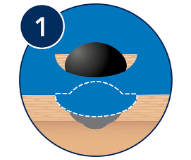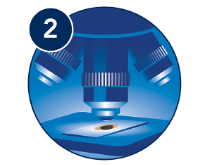
For Patients of Dermatology Professionals
Mohs Surgery
- Mohs surgery, also called Mohs or Mohs micrographic surgery, is a specialized treatment for removing certain skin cancers that combines surgery with microscopic margin analysis. Mohs surgery is the most effective treatment for skin cancer today. Your dermatologist will determine if Mohs surgery is appropriate for treating your skin cancer, depending on the type of skin cancer you have, its size and its location on your body.
What is Mohs Surgery?
- Mohs surgery is the surgical removal of skin cancer from your skin. It is the only treatment method that allows for evaluation of the margins (areas surrounding the visible skin cancer) while you wait, ensuring that all skin cancer cells have been removed before you leave the office. This results in the removal of the least amount of healthy tissue, which is especially important when skin cancer develops in a sensitive area where it is important to preserve as much healthy tissue as possible.
- Most Mohs surgeons are board-certified dermatologists who have completed additional training in Mohs surgery. Mohs surgeons not only perform the surgery, but also examine the tissue under the microscope to ensure all cancer cells have been removed.
- Mohs surgeons often also have training in reconstructive techniques to enhance healing and minimize scarring.
How is Mohs Surgery Performed?
- Mohs surgery is usually performed as an outpatient procedure in a dermatologist’s office. You remain awake during Mohs surgery and receive a local anesthetic to numb the surgical area. The use of a local anesthetic instead of general anesthesia (which puts the patient to sleep) is much safer, and it reduces recovery time with fewer side effects.
- If you are concerned about discomfort during the procedure, share your concerns with the Mohs surgeon to see how he/she can make you feel more comfortable.
- Once the anesthesia has taken effect, the Mohs surgeon removes the visible skin cancer. The removed tissue is processed in the lab and then examined under a microscope by the Mohs surgeon to determine if there are any cancer cells remaining at the margins of the removed tissue. During this time, you wait in the surgical suite or office.
- If cancer cells are still present at any edge of the removed tissue, the Mohs surgeon will continue to remove skin specifically at the location where the cancer cells remain. You will wait for the tissue to be processed and for the Mohs surgeon to examine it under a microscope again.
~ This process is repeated until all cancer cells have been removed. ~
- After the Mohs surgery is completed, your Mohs surgeon will discuss with you the best way for the wound to heal. Stitches may be required, or your wound may be bandaged and allowed to heal on its own. Any surgical repair is usually performed on the same day. Your Mohs surgeon will determine the best approach with you. In certain instances, you may be referred to another medical doctor to repair the wound.
- Each review of the removed skin can take one to two hours. In almost all cases, Mohs surgery can be completed within a day or less.
What to Expect During Mohs Surgery?
1. The visible tumor and a small segment of surrounding skin are removed.

2. The tissue is examined under a microscope to see if any cancer cells remain at any of the edges.

3. If any cancer remains, additional skin continues to be removed and examined under the microscope.

4. This process continues until no more cancer cells are found.

When is Mohs Surgery the Best Treatment Option?
- Most Mohs patients have a common type of skin cancer like basal cell carcinoma (BCC) or squamous cell carcinoma (SCC). Mohs is usually recommended when a BCC or SCC:
- Is aggressive or large
- Appears in an area with little tissue beneath it (e.g., eyelid, nose, ear, scalp, genitals, hand or foot)
- Was treated and has returned
- Mohs surgery can be used to treat sensitive areas – such as on the face, an ear, a finger or a toe – because the Mohs surgeon attempts to remove as little normal skin as possible while ensuring that the entire skin cancer is removed.
- Mohs surgery is also useful for other types of aggressive or difficult-to-treat skin cancers, such as those that are rapidly growing, are large, have poorly defined borders or regrow following a previous treatment.
- Mohs is also used to treat some rare skin cancers likes DFSP, extramammary Paget’s disease, and Merkel cell carcinoma.
Why do Dermatologist recommend Mohs Surgery?
- Dermatologists recommend Mohs surgery because it preserves as much normal, healthy tissue as possible and has a high cure rate.
Is Mohs Surgery the Best Skin Cancer Treatment?
- While Mohs surgery has many advantages, it is not the right treatment for everyone or for every skin cancer. Your dermatologist will consider many factors before determining if Mohs surgery is right for you. These factors include the type of skin cancer and its location, as well as your overall health.
- Your dermatologist will evaluate all possible options and help determine the best treatment for you.
For more information, please visit:
